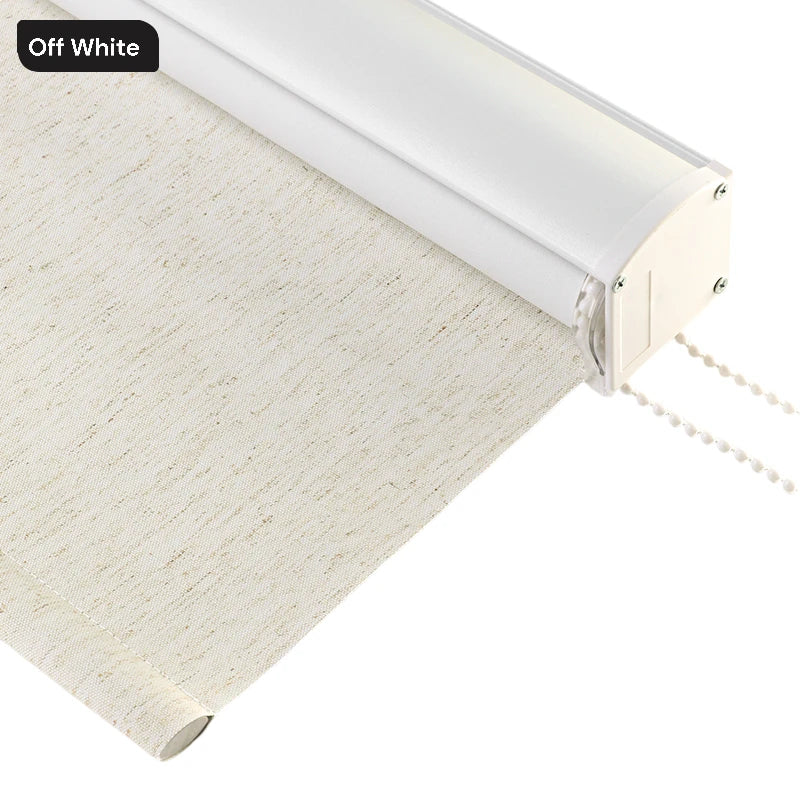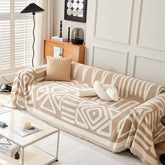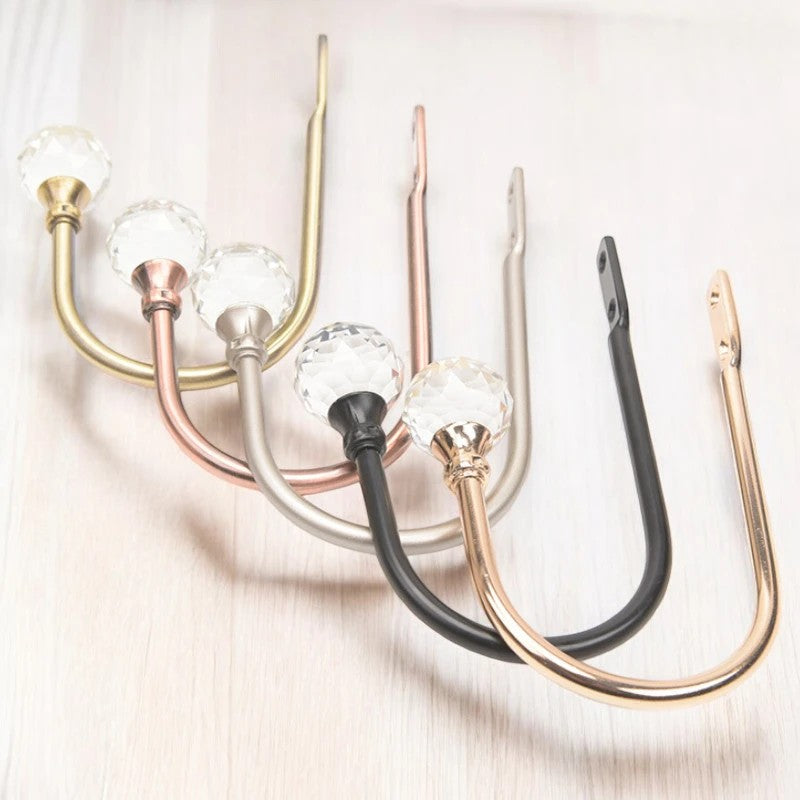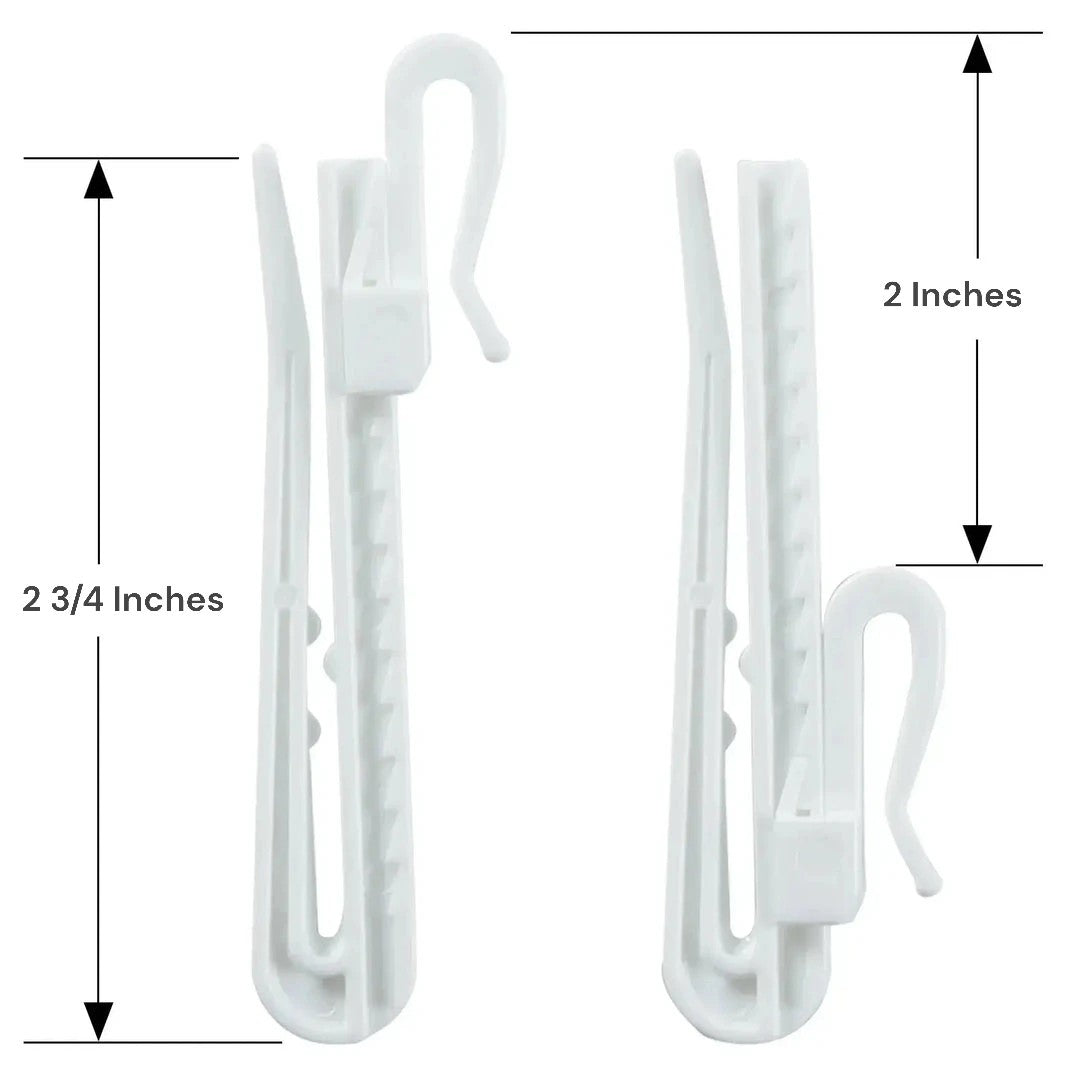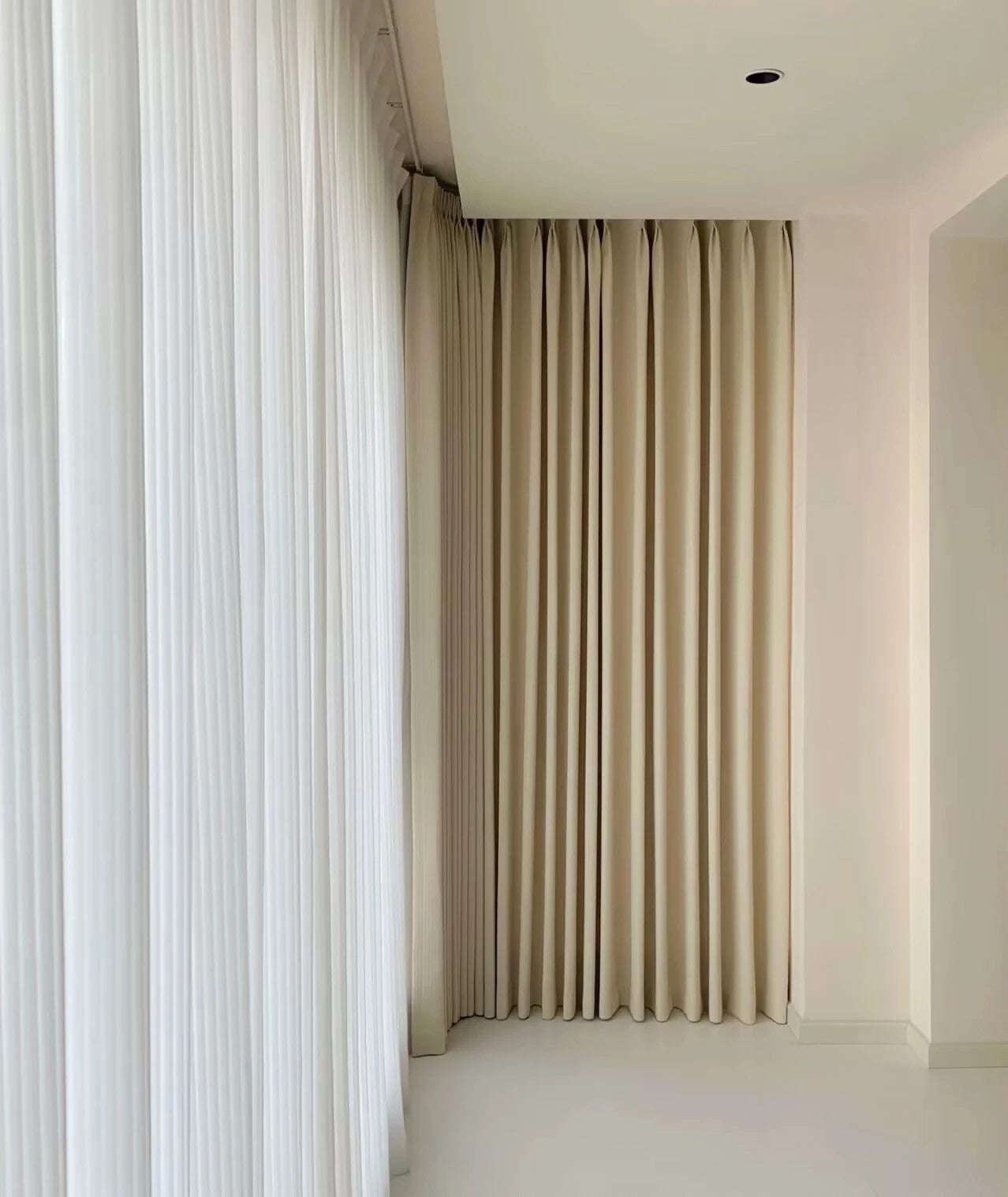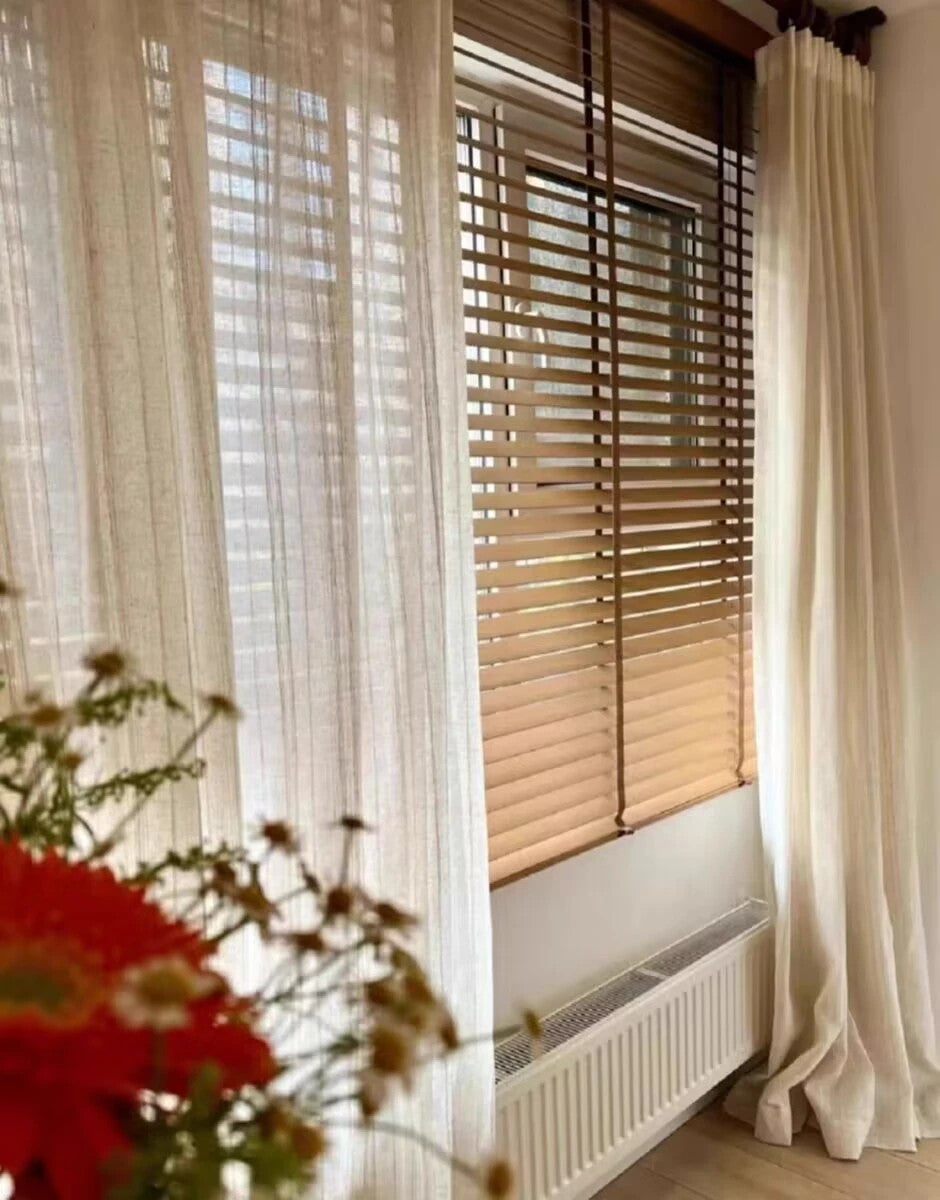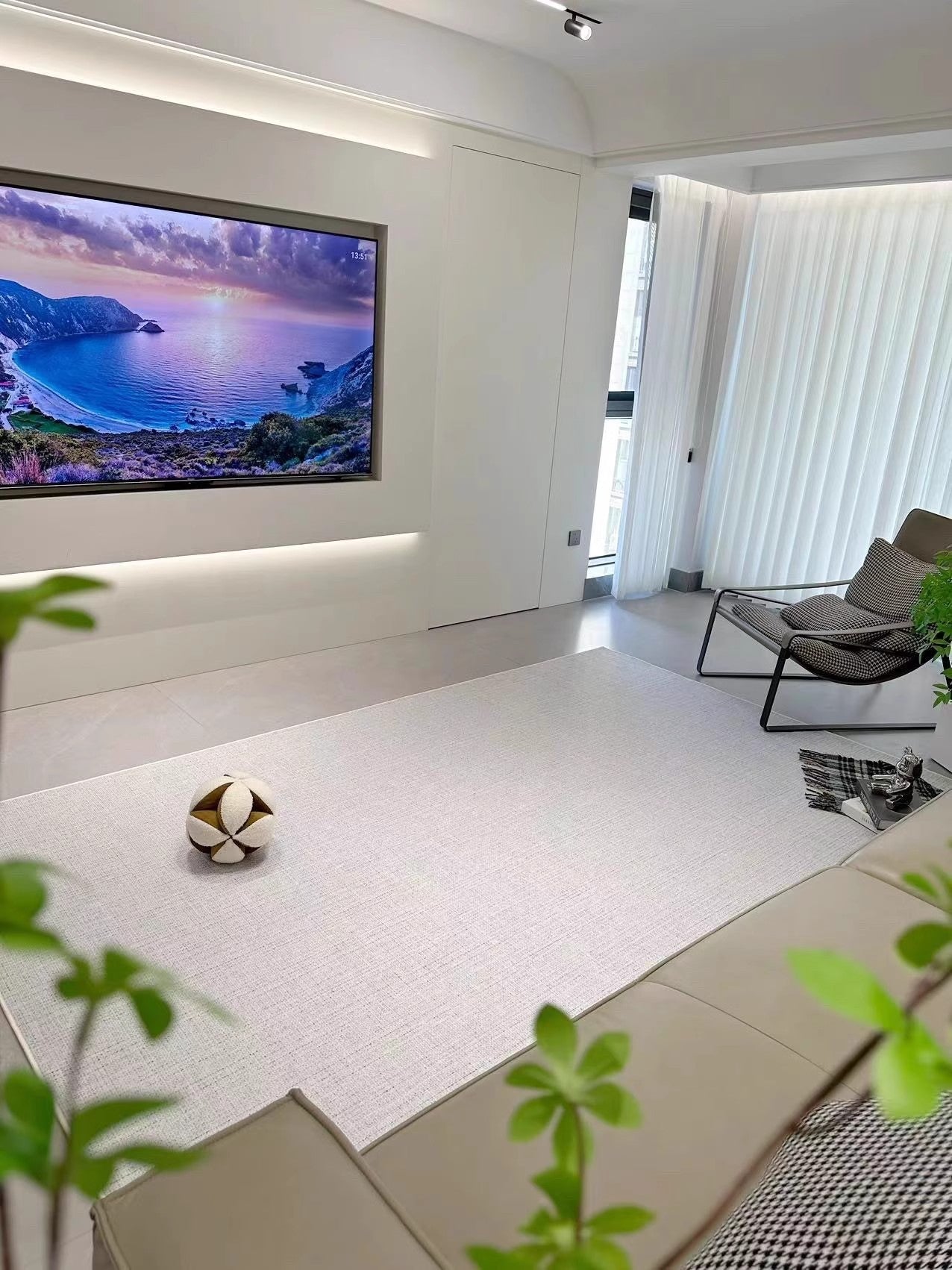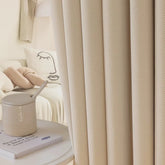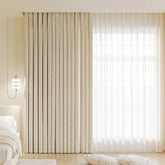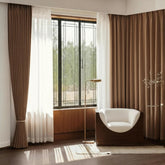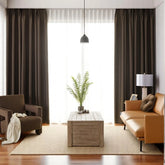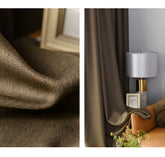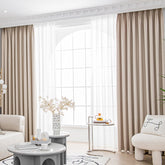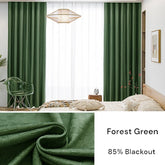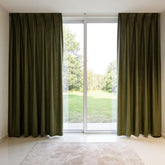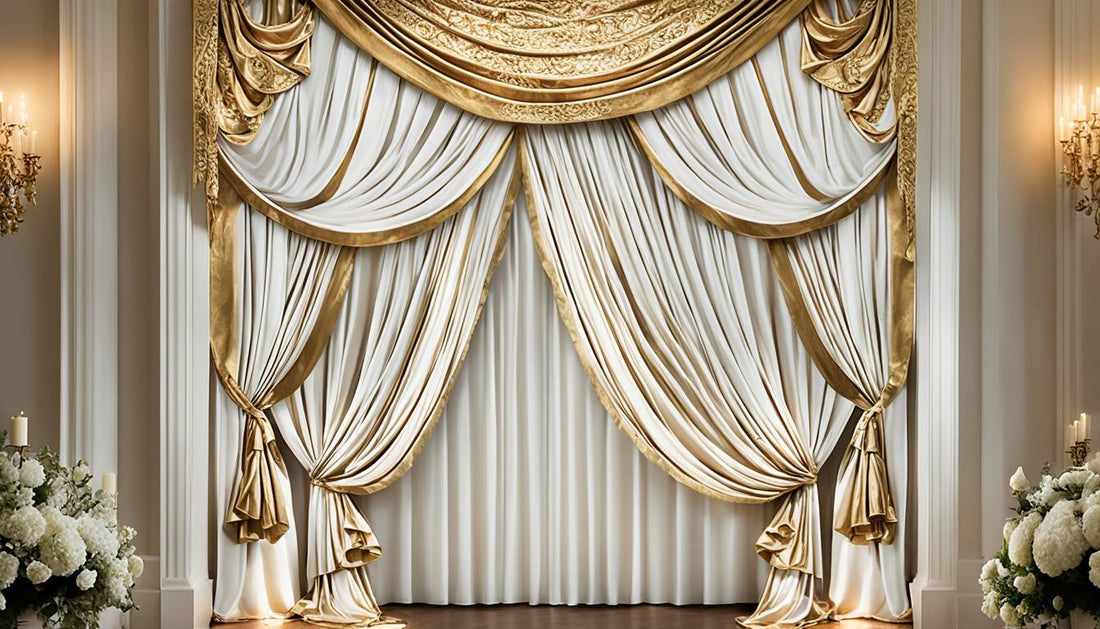Portiere Curtains 101: Everything You Need to Know
Hey there! James here from Dolcewe.com. Today, I'm excited to chat with you about portiere curtains. These nifty curtains can really spruce up your home.
Let's dive in and learn all about them!
Key Takeaways
| Main Section | Key Takeaway |
|---|---|
| What Are Portiere Curtains? | Portiere curtains are versatile door hangings that offer privacy, insulation, and style. Consider using them to enhance doorways and create distinct spaces in your home. |
| Types of Portiere Curtains | Choose from a variety of fabrics like sheer, blackout, or velvet to suit your needs. Match the fabric to your room's function and decor for the best results. |
| Styles of Portiere Curtains | Select from formal, casual, bohemian, Victorian, or modern styles to complement your interior design. Experiment with different styles to create unique looks in various rooms. |
| Hanging Methods | Consider rod pocket, tab top, pinch pleat, grommet, or rising mechanisms based on your preference and ease of use. Choose a method that balances aesthetics with functionality for your space. |
| Choosing the Right Portiere Curtains | Consider the doorway's function, match the style to your decor, and measure accurately. Take time to assess your needs and room aesthetics to make the best choice. |
| Installation Methods | Choose from mounting within the doorframe, above the doorway, or using pressure rods. Select the method that best suits your doorway structure and desired look. |
| Modern Applications | Use portieres for room division, closet covers, or to create cozy nooks. Think creatively about how portieres can solve design challenges in your home. |
| Portiere Curtains in Interior Design | Use portieres to create visual flow, layer textures, or enhance period decor. Experiment with different design techniques to elevate your interior spaces using portiere curtains. |
What Are Portiere Curtains?
Portiere curtains are special curtains that hang in doorways or archways.
They're not for windows! The word "portiere" comes from the French word "porte," which means door.
Some folks also call them door curtains, doorway curtains or archway curtains.
Portiere curtains have been around for a long time. People first used them in castles way back in the 4th century!
But they got really popular in the 1800s when Queen Victoria ruled England.
People loved them so much, they kept using them until the 1940s.
Fabric Types of Portiere Drapes
Sheer Portiere Curtains

Sheer portiere curtains are made from lightweight, see-through fabrics like polyester or voile.
They allow light to filter through while providing a soft, airy look to doorways.
Best for: Rooms where you want to maintain an open feel while adding a touch of elegance. They're great for living rooms, dining areas, or bedrooms with connecting spaces.
Tips:
-
Layer sheer portieres with heavier curtains for versatility
-
Choose a double-width sheer for fuller coverage
-
Opt for UV-resistant sheers to protect furnishings from sun damage
Blackout Curtains

Blackout portiere curtains are made from thick, tightly woven fabrics designed to block out light completely.
They offer maximum privacy and light control between rooms.
Best for: Bedrooms adjacent to living areas, home theaters, or any space where you want to control light and sound transfer between rooms.
Cons:
-
May make spaces feel closed off or dark
-
Can be heavier and more difficult to open/close frequently
-
Often more expensive than lighter fabrics
Tips:
-
Choose a rod that can support the weight of blackout curtains
-
Consider a tie-back option for easy opening during the day
-
Look for blackout portieres with decorative patterns to add visual interest
Velvet Drapery
Velvet portiere curtains are luxurious and heavy, made from a soft, plush fabric with a distinctive pile.
They add a touch of elegance and warmth to doorways.
Best for: Formal living rooms, master bedrooms, or studies where you want to create a rich, sophisticated atmosphere.
Tips:
-
Use sturdy mounting hardware to support the weight of velvet curtains
-
Choose lighter colors in small spaces to avoid overwhelming the room
-
Consider velvet portieres with a subtle sheen for added glamour
Brocade Portiere Curtains
Brocade curtain panels feature intricate woven patterns, often with a raised design. They add texture and visual interest to doorways while providing good coverage.
Best for: Traditional or formal spaces where you want to make a statement, such as dining rooms or grand entryways.
Cons:
-
May be too busy for some interior styles
-
Can be expensive due to the complex weaving process
-
Patterns may limit flexibility in changing room decor
Tips:
-
Choose a brocade pattern that complements your existing decor
-
Use simpler furnishings to balance the ornate curtains
-
Consider custom-made brocade portieres for a perfect fit and pattern match
Damask Portiere Curtains

Damask portiere curtains feature a reversible pattern woven into the fabric, typically with a subtle sheen.
They offer elegance with a more subdued look compared to brocade.
Best for: Versatile enough for various rooms, damask portieres work well in bedrooms, living rooms, or dining areas where you want a touch of sophistication.
Tips:
-
Choose a damask pattern that's proportional to your doorway size
-
Consider lined damask portieres for better insulation and durability
-
Mix damask with solid-colored curtains in adjacent rooms for balance
Wool Portiere Curtains

Wool portiere curtains are made from natural fibers, offering excellent insulation and a cozy feel. They're durable and can add warmth to doorways both visually and physically.
Best for: Colder climates or drafty homes where insulation is important. Great for bedrooms, living rooms, or studies.
Tips:
-
Choose a wool blend for easier care and less weight
-
Consider wool portieres with a lining for added insulation
-
Use wool curtains seasonally in colder months if your climate varies
Cotton Portiere Curtains
Cotton portiere curtains are versatile, breathable, and easy to care for.
They come in various weights and can be casual or formal depending on the weave and finish.
Best for: Versatile enough for any room, cotton portieres are especially good for casual spaces like family rooms, kitchens, or children's rooms.
Cons:
-
May wrinkle easily
-
Lighter weights offer less insulation and privacy
-
Can fade if exposed to direct sunlight
Tipss:
-
Choose a heavier weight cotton for better draping and privacy
-
Look for cotton blends for added durability and wrinkle resistance
-
Consider lined cotton portieres for better light blocking and insulation
Remember, at Dolcewe.com, we offer all these fabric types in custom sizes to fit your unique doorways perfectly.
Our portieres start at just $26.99, and we're always here to help you choose the best option for your home!
Styles of Portiere Door Curtains

Formal Portiere Curtains
Formal portiere curtains are elegant and luxurious, often made from heavy fabrics like velvet, chenille or damask.
They feature rich colors and may include ornate details like tassels or fringe.
Best for: Creating a sophisticated atmosphere in living rooms, dining areas, or master bedrooms.
They're ideal for homes with traditional or classic decor.
Tips:
-
Choose deep, rich colors like burgundy, navy, or emerald for a regal look
-
Add decorative tiebacks or holdbacks for a polished appearance
-
Consider lined curtains for better insulation and a fuller drape
-
Pair with elegant hardware like brass or crystal finials
Casual Portiere Curtains
Casual portiere curtains are relaxed and comfortable, often made from lightweight fabrics like cotton or linen.
They have a laid-back, effortless style that suits everyday living spaces.
Best for: Creating a welcoming, informal atmosphere in family rooms, kitchens, or casual dining areas. They work well in homes with a relaxed or coastal decor style.
Bohemian Portiere Curtains

Bohemian portiere curtains are eclectic and free-spirited, often featuring bold patterns, vibrant colors, and unique textures.
They may incorporate elements like tassels, beads, or embroidery.
Best for: Adding a touch of whimsy and creativity to living spaces, bedrooms, or home offices. They're perfect for those who love an artistic, unconventional decor style.
Victorian Portiere Curtains

Victorian portiere curtains are ornate and dramatic, often made from heavy fabrics like velvet or brocade.
They feature elaborate designs, rich colors, and may include tassels, fringe, or other decorative trims.
Best for: Creating a sense of grandeur in formal living rooms, dining rooms, or studies. They're ideal for period homes or those looking to add a touch of historical elegance.
Modern Portiere Curtains
Modern portiere curtains are sleek and minimalist, often featuring clean lines and simple designs.
They may be made from a variety of materials, including sheer fabrics or heavier textiles with a subtle texture.
Best for: Creating a contemporary look in open-plan living spaces, loft apartments, or minimalist homes. They're perfect for those who prefer a clean, uncluttered aesthetic.
Tips:
-
Opt for solid colors or subtle geometric patterns
-
Choose curtain rods with a simple, streamlined design
-
Consider using grommet or wave-style headers for a clean look
-
Experiment with unconventional materials like metal mesh or laser-cut panels
At Dolcewe.com, we offer a wide range of portiere curtains in all these styles, starting from just $26.99.
Our custom sizing ensures a perfect fit for any doorway, and we're always here to help you choose the best option for your home!
Hanging Methods for Portiere Curtains
Rod Pocket Portiere Curtains
Rod pocket portiere curtains have a sewn-in casing at the top that slides directly onto the curtain rod. This creates a gathered, soft look when hung.
-
Easy to install - simply slide onto the rod
-
Creates a classic, casual appearance
-
Hides the curtain rod for a clean look
-
Affordable option
Tips:
-
Choose a rod diameter that fits snugly in the pocket for best appearance
-
Use curtain rings with clips for easier opening/closing if needed
-
Steam or iron the top portion to reduce wrinkles from gathering
-
Consider a larger rod pocket for heavier fabrics
Tab Top Portiere Curtains
Tab top portiere curtains have fabric loops sewn into the top edge that slip over the curtain rod. This creates an informal, relaxed look.
-
Easy to hang and remove
-
Creates evenly spaced pleats
-
Allows curtains to slide smoothly
-
Works well with decorative rods
Tips:
-
Use decorative curtain rods to enhance the exposed rod look
-
Choose sturdy fabric for tabs to prevent stretching
-
Add curtain clips to the back of the tabs for extra support
-
Consider lining the curtains for more privacy
Pinch Pleat Portiere Curtains
Pinch pleat portiere curtains have evenly spaced, sewn-in pleats at the top, creating a formal and tailored appearance.
-
Elegant and sophisticated look
-
Excellent light control and privacy
-
Hangs beautifully when both open and closed
-
Works well with traverse rods for easy opening/closing
Eyelet/Grommet Portiere Curtains
Eyelet or grommet portiere curtains have metal rings embedded in the top edge that slide directly onto the curtain rod.
-
Modern, sleek appearance
-
Easy to open and close
-
Creates even, consistent folds
-
Works well with thicker decorative rods
Tips:
-
Choose a rod diameter that complements the grommet size
-
Use silent glide rings for quieter operation
-
Layer with sheer curtains for added privacy
-
Select a rod finish that matches or complements the grommets
Rising Portiere Mechanism
A rising portiere mechanism allows the curtain to be raised and lowered vertically, similar to a roman shade.
-
Unique and functional design
-
Saves space in narrow doorways
-
Allows for adjustable privacy and light control
-
Can create an interesting architectural feature
At Dolcewe.com, we offer all these hanging methods for our portiere curtains, starting at just $26.99. Our expert team can help you choose the best option for your specific doorway and style preferences.
Remember, we also offer custom sizing to ensure a perfect fit for any space in your home!
Choosing the Right Portiere Curtains
Consider the Function of the Doorway/Archway
When selecting portiere curtains, it's crucial to think about how the doorway or archway is used. Here are some key considerations:
-
Traffic flow: For high-traffic areas, choose durable fabrics that can withstand frequent movement. Consider using tie-backs or holdbacks to keep curtains open during busy times.
-
Privacy needs: If you're using the portiere to separate private spaces, opt for heavier fabrics or blackout options.
-
Temperature control: For doorways between rooms with different temperatures, choose insulating fabrics to help maintain comfort in both spaces.
-
Noise reduction: If sound dampening is a priority, look for thick, dense fabrics or consider layering curtains for better acoustic properties.
Actionable tip: Make a list of your doorway's primary functions and rank them in order of importance. This will guide your fabric and style choices.
Match Curtain Style to Overall Room Décor
Portiere curtains should complement your existing décor. Here's how to ensure a cohesive look:
-
Color coordination: Choose curtains that either match or contrast beautifully with your wall color and furnishings. Don't be afraid to use portiere curtains as a statement piece!
-
Pattern play: If your room has mostly solid colors, consider patterned portiere curtains to add visual interest. Conversely, if your space is already pattern-heavy, opt for solid curtains to balance the look.
-
Texture considerations: Match the texture of your portiere curtains to the overall feel of your room. Velvet or heavy brocades work well in formal spaces, while linen or cotton suits casual environments.
-
Style consistency: Ensure the curtain style aligns with your interior design theme. For example, tab-top curtains suit modern spaces, while pinch pleats are perfect for traditional rooms.
Take photos of your room and bring fabric swatches home to see how they look in your space before making a final decision.
Measure Doorway/Archway Accurately
Precise measurements are crucial for a polished look. Follow these steps:
-
Width: Measure the width of your doorway or archway at its widest point. Add 4-6 inches on each side for optimal coverage and light blocking.
-
Height: For doorways, measure from the top of the frame to where you want the curtains to fall (usually just touching the floor). For arches, measure from the highest point to your desired endpoint.
-
Depth: If mounting inside the doorframe, measure the depth to ensure your chosen rod will fit.
-
Rod placement: Decide if you want to mount the rod inside or outside the doorframe. Outside mounting can make the doorway appear larger.
Use a metal tape measure for accuracy, and measure twice to avoid costly mistakes. Consider professional measuring services for uniquely shaped archways.
Fabric Selection Tips
Choosing the right fabric is crucial for both functionality and aesthetics. Here are some key considerations:
Light Filtering vs. Blackout
-
Light filtering fabrics: These allow some light to pass through, creating a soft, diffused effect. They're great for spaces where you want to maintain a bright atmosphere while still providing some privacy.
-
Blackout fabrics: These block out almost all light, making them ideal for bedrooms or areas where you need complete privacy and darkness.
For versatility, consider using double rods with both light filtering and blackout curtains. This allows you to adjust light levels throughout the day.
Washability
-
Machine washable fabrics: Cotton, polyester, and some synthetic blends are easy to clean at home. These are ideal for high-traffic areas or homes with children and pets.
-
Dry clean only fabrics: Silk, velvet, and some delicate fabrics require professional cleaning. While beautiful, they may be less practical for everyday use.
Check care labels before purchasing. If you prefer low-maintenance options, stick to machine washable fabrics or consider removable liners for easier cleaning.
Insulation Properties
-
Thermal curtains: These have special linings or layers that help regulate temperature. They're excellent for doorways leading to outdoor spaces or between rooms with different temperature needs.
-
Heavy fabrics: Materials like velvet, suede, and heavy cotton naturally provide better insulation than lighter fabrics.
-
Layered options: Combining a sheer curtain with a heavier drape can provide both style and insulation flexibility.
Feel the weight of the fabric – generally, heavier fabrics provide better insulation. For maximum efficiency, ensure curtains are wide enough to overlap the doorway edges when closed.
Installation Methods for Portiere Curtains
Mounted Within Doorframe
This method involves installing the curtain rod directly inside the doorframe, creating a sleek, built-in look.
Step-by-step process:
-
Measure the inside width of your doorframe.
-
Choose a tension rod or adjustable curtain rod that fits snugly.
-
Install brackets (if not using a tension rod) slightly below the top of the doorframe.
-
Slide your curtain onto the rod.
-
Mount the rod securely within the doorframe.
Tips:
-
Use a level to ensure your rod is straight.
-
For heavy curtains, reinforce the brackets with wall anchors.
-
Consider using rubber tips on tension rods to prevent slipping and protect the doorframe.
Hung on Rod Above Doorway
This classic method allows for fuller curtains and can make your doorway appear larger.
Step-by-step process:
-
Measure the width of your doorway and add 4-6 inches on each side.
-
Mark your bracket positions about 4-6 inches above the doorframe.
-
Install the brackets using a drill and appropriate anchors.
-
Slide your curtain onto the rod.
-
Place the rod onto the brackets and secure.
Tips:
-
Use a stud finder to locate the most secure mounting points.
-
For a luxurious look, hang the rod even higher to create the illusion of taller ceilings.
-
Consider decorative finials to add a stylish touch to your rod ends.
Using Pressure Rods for Easy Removal
Pressure rods offer a no-drill solution, perfect for renters or those who like to change decor frequently.
Step-by-step process:
-
Measure the inside width of your doorframe.
-
Choose a pressure rod that extends slightly beyond this measurement.
-
Twist the rod to extend it to the desired length.
-
Slide your curtain onto the rod.
-
Press the rod firmly into place within the doorframe.
Tips:
-
Clean the contact points in the doorframe for better grip.
-
For heavier curtains, look for heavy-duty pressure rods with rubber ends.
-
Check and re-tighten the rod periodically to ensure it stays secure.
Cosidor Method
The Cosidor method offers a unique and sleek installation option for portiere curtains.
Step-by-step process:
-
Measure your door frame width and height.
-
Cut the Cosidor track to fit your doorframe width.
-
Attach the track to the top of the doorframe using screws.
-
Slide the curtain hooks into the track.
-
Hang your curtain on the hooks.
Tips:
-
Use a miter saw for clean cuts on the Cosidor track.
-
Pre-drill holes in the track for easier screw installation.
-
Consider using decorative curtain hooks for added style.
Modern Applications of Portiere Curtains
In Period Home Restorations
Portiere curtains are making a comeback in period home restorations, adding authenticity and charm to historical interiors.
Actionable suggestions:
-
Research the specific era of your home to choose historically accurate fabrics and patterns
-
Consider using antique or vintage hardware for an authentic look
-
Pair portieres with other period-appropriate window treatments for a cohesive design
-
Use portieres to highlight original architectural features like arched doorways
As Room Dividers in Open Floor Plans
In modern open-concept homes, portiere curtains offer a flexible way to create separate spaces without permanent walls.
Tips:
-
Install ceiling-mounted tracks for easy opening and closing of room-dividing portieres
-
Choose fabrics that complement both adjoining spaces
-
Use double-sided portieres with different colors or patterns on each side to define distinct areas
-
Consider sheer or semi-sheer fabrics to maintain an open feel while providing visual separation
For Doorless Closets or Bathrooms
Portiere curtains provide privacy and style for doorless closets and bathrooms, especially in smaller homes or apartments.
Tips
-
Use moisture-resistant fabrics for bathroom applications
-
Install tension rods for easy installation and removal in rental properties
-
Choose patterns or colors that complement your existing decor
-
Add a tieback to keep the curtain open when not in use for privacy
Creating Cozy Nooks in Large Spaces
Portieres can be used to carve out intimate areas within larger rooms, creating cozy reading nooks or meditation spaces.
Tips:
-
Use corner-mounted rods to create a semi-circular nook
-
Layer different fabrics for added texture and insulation
-
Add soft lighting behind the portiere for a warm, inviting atmosphere
-
Coordinate the portiere fabric with throw pillows or a small area rug to define the space
Adding Architectural Interest
In modern homes lacking traditional architectural details, portieres can add visual interest and a sense of history.
Actionable suggestions:
-
Use ornate rods and finials to create a focal point
-
Choose bold patterns or rich textures to make a statement
-
Install portieres in unexpected places, like framing a large window or piece of art
-
Layer portieres with existing window treatments for added depth and luxury
Layering Textures and Patterns
Portiere curtains offer an excellent opportunity to add depth and interest to your interior design through thoughtful layering.
Actionable suggestions:
-
Combine different fabric weights, like pairing a heavy velvet portiere with sheer window curtains
-
Mix patterns by using a solid-colored portiere with patterned wallpaper or upholstery
-
Add texture with embroidered or appliquéd portieres
-
Use trims, tassels, or fringe to enhance the curtain's tactile appeal
Enhancing Period-Appropriate Decor
For those restoring period homes or creating historically inspired interiors, portieres can add authenticity and charm.
Actionable suggestions:
-
Research curtain styles specific to your home's era
-
Use historically accurate fabrics and patterns
-
Incorporate period-appropriate hardware, like ornate rods and finials
-
Consider adding valances or pelmets for a more authentic look
Portieres were an essential element in homes during the high Aesthetic Movement of the 19th century.
They became part of the 'must-haves' for a stylish home of that era. In period restorations, carefully chosen portieres can significantly contribute to the overall historical accuracy of the interior.
Shop for Portiere Curtains at Dolcewe
At Dolcewe.com, we have lots of great custom portiere curtains:
- Many styles, fabrics, colors, and patterns
- Custom sizes to fit your doorway perfectly
- Prices start at just $26.99
- Free shipping on orders over $199
- Get an extra 10% off when you sign up
Portiere curtains are a great way to make your home look nice and feel cozy. They're easy to use and come in lots of styles.
Whether you want to keep warm, have privacy, or just make your home look pretty, portiere curtains can help. Why not try some in your home?
Visit Dolcewe.com to find the perfect portiere curtains for you!



